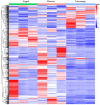Effects of Different Rearing Systems on Lueyang Black-Bone Chickens: Meat Quality, Amino Acid Composition, and Breast Muscle Transcriptome
- PMID: 36292783
- PMCID: PMC9601429
- DOI: 10.3390/genes13101898
Effects of Different Rearing Systems on Lueyang Black-Bone Chickens: Meat Quality, Amino Acid Composition, and Breast Muscle Transcriptome
Abstract
The quality of poultry products depends on genotype, rearing system, and environment. The aim of this study was to investigate the effects of different rearing systems on meat quality, amino acid composition, and breast muscle transcriptome from Lueyang black-bone chickens. Lueyang black-bone chickens (n = 900) were randomly divided into three groups (cage, flat-net, and free-range groups), with three replicates per group (100 chickens per replicate). At 16 weeks, a total of 36 healthy chickens (six males and six females per group) were collected, and their breast muscles were sampled to detect meat quality parameters, amino acid composition, and fatty acid contents. Furthermore, breast muscles from six random hens in each group were used for RNA-seq analysis. The results revealed that the values of pH, shear force, inosine monophosphate (IMP), palmitic acid, and linoleic acid in the free-range group were significantly higher than those in the caged group (p < 0.05). Fat content in the free-range group was significantly lower than in the caged and flat-net groups (p < 0.05). Glutamate (Glu) levels, the amino acid crucial for the umami taste, was significantly higher in the free-range group than in the caged group (p < 0.05). Meanwhile, there was no significant difference between the free-range and flat-net groups (p > 0.05). The breast muscle transcriptome results showed that there were 291, 131, and 387 differently expressed genes (DEGs) among the three comparison groups (caged vs. free-range, flat-net vs. caged, and flat-net vs. free-range, respectively) that were mainly related to muscle development and amino acid metabolism pathways. To validate the accuracy of the transcriptome data, eight genes (GOS2, ASNS, NMRK2, GADL1, SMTNL2, SLC7A5, AMPD1, and GLUL) which relate to fat deposition, skeletal muscle function, and flavor formation were selected for Real-time Quantitative PCR (RT-qPCR) verification. In conclusion, these results suggested that rearing systems significantly influenced the meat quality and gene expression of Lueyang black-bone chickens. All the data proved that free-range and flat-net systems may provide better flavor to consumers by affecting the deposition of flavor substances and the expression of related genes. These findings will provide a valuable theoretical basis for the rearing system selection in the poultry industry.
Keywords: Lueyang black-bone chicken; different expressed genes; meat quality; rearing system; transcriptome.
Conflict of interest statement
The authors declare no conflict of interest.
Figures




Similar articles
-
Identification of Metabolites in Muscles of Lueyang Black-Bone Chickens: A Comparative Analysis of Caged and Cage-Free Rearing Modes Using Untargeted Metabolomic Techniques.Animals (Basel). 2024 Jul 12;14(14):2041. doi: 10.3390/ani14142041. Animals (Basel). 2024. PMID: 39061503 Free PMC article.
-
Integrative metabolomics and transcriptomics analysis revealed specific genes and metabolites affecting meat quality of chickens under different rearing systems.Poult Sci. 2024 Sep;103(9):103994. doi: 10.1016/j.psj.2024.103994. Epub 2024 Jun 24. Poult Sci. 2024. PMID: 38991385 Free PMC article.
-
Transcriptome analysis reveals the role of long noncoding RNAs in specific deposition of inosine monphosphate in Jingyuan chickens.J Anim Sci. 2024 Jan 3;102:skae136. doi: 10.1093/jas/skae136. J Anim Sci. 2024. PMID: 38738625 Free PMC article.
-
Transcriptomic analysis of thigh muscle of Lueyang black-bone chicken in free-range and caged feeding.Anim Biotechnol. 2023 Nov;34(4):785-795. doi: 10.1080/10495398.2021.1993235. Epub 2021 Dec 29. Anim Biotechnol. 2023. PMID: 34965837
-
Unraveling the flavor profiles of chicken meat: Classes, biosynthesis, influencing factors in flavor development, and sensory evaluation.Compr Rev Food Sci Food Saf. 2024 Jul;23(4):e13391. doi: 10.1111/1541-4337.13391. Compr Rev Food Sci Food Saf. 2024. PMID: 39042376 Review.
Cited by
-
Influence of slaughter age on meat quality, metabolite and volatile organic compound changes in Lueyang black-bone chickens.Poult Sci. 2025 Jun 3;104(9):105390. doi: 10.1016/j.psj.2025.105390. Online ahead of print. Poult Sci. 2025. PMID: 40483908 Free PMC article.
-
Use of GC-IMS and Stoichiometry to Characterize Flavor Volatiles in Different Parts of Lueyang Black Chicken during Slaughtering and Cutting.Foods. 2024 Jun 15;13(12):1885. doi: 10.3390/foods13121885. Foods. 2024. PMID: 38928826 Free PMC article.
-
Genetic Evaluation of Growth Traits in Black-Boned and Thai Native Synthetic Chickens Under Heat Stress.Animals (Basel). 2025 Aug 7;15(15):2314. doi: 10.3390/ani15152314. Animals (Basel). 2025. PMID: 40805103 Free PMC article.
-
Identification of Metabolites in Muscles of Lueyang Black-Bone Chickens: A Comparative Analysis of Caged and Cage-Free Rearing Modes Using Untargeted Metabolomic Techniques.Animals (Basel). 2024 Jul 12;14(14):2041. doi: 10.3390/ani14142041. Animals (Basel). 2024. PMID: 39061503 Free PMC article.
-
Strand-Specific RNA Sequencing Reveals Gene Expression Patterns in F1 Chick Breast Muscle and Liver after Hatching.Animals (Basel). 2024 Apr 29;14(9):1335. doi: 10.3390/ani14091335. Animals (Basel). 2024. PMID: 38731340 Free PMC article.
References
-
- Dang L.-P., Liu R.-F., Zhao W.-Y., Zhou W.-X., Min Y.-N., Wang Z.-P. Investigating structural impact of a valine to isoleucine substitution on anti-Müllerian hormone in silico and genetic association of the variant and AMH expression with egg production in chickens. J. Integr. Agric. 2020;19:1635–1643. doi: 10.1016/S2095-3119(20)63176-8. - DOI
Publication types
MeSH terms
Substances
LinkOut - more resources
Full Text Sources
Miscellaneous

